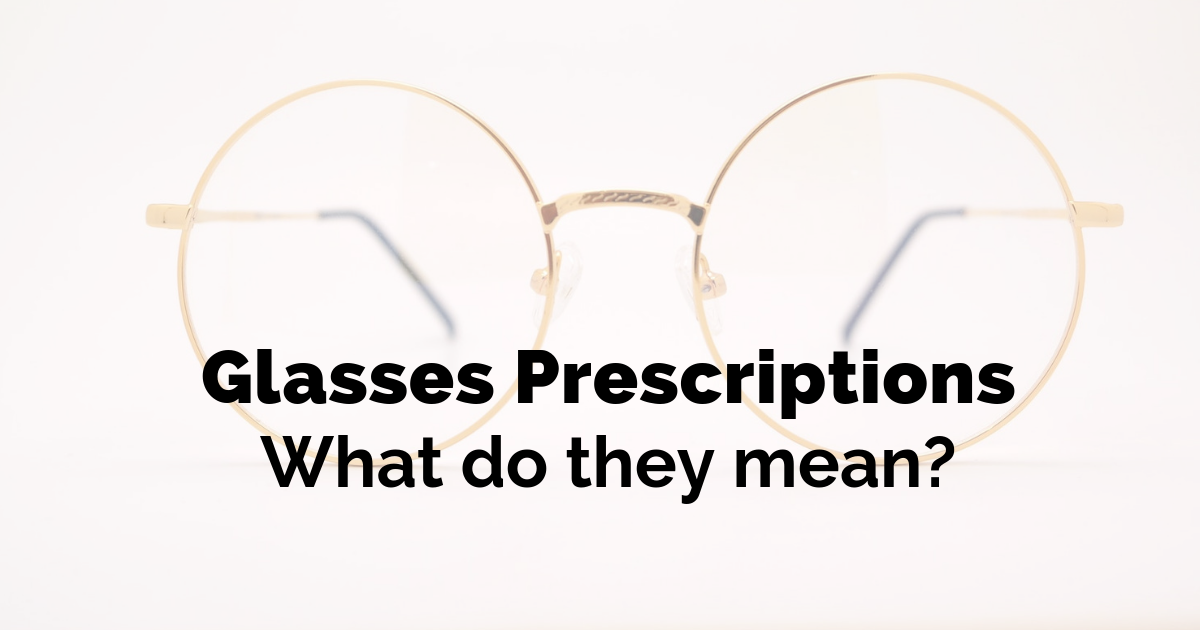If you have returned from your eye test a little confused about your prescription, don’t worry. The abbreviations, boxes, and numbers with little decimal points bewilder a lot of people, so it’s not just you! A lot of us go along with our prescription without question, but if you want to learn what is going on behind your eyes, read on.
Here are some of the most common questions:
- What does OD and OS in my prescription mean?
- What is Sphere vs Cylinder vs Axis?
- What is the difference between negative and positive numbers in my prescription
- How bad is my eye prescription?
Do not worry, We’ll help you decipher the main parts of your prescription so that when you next visit your optician, you‘ll actually be able to discuss your eyes in confidence.
Reading a glasses prescription: An example
| SPHERE | CYLINDER | AXIS | ||||
|
DISTANCE |
R |
-1.50 |
||||
|
L |
-2.00 |
-0.50 |
160 |
|||
| ADD | R | +1.00 |
ADDITIONAL NOTES |
|||
|
L |
+1.00 |
|||||
Glasses prescription meaning
Above is an example of a modern glasses prescription sheet. Refer to this model while we explain the terminology and the figures. Bear with us – all will be clear shortly.
Right (OD) and left (OS) eye
Let’s start with R and L. These are abbreviations for right and left in relation to your eyes. Some prescriptions may use OD and OS which stand for oculus dexter and ‘oculus sinister’, and are the Latin terms for your right eye and your left eye.
Most prescriptions use the modern labelling system of R and L however, some opticians still use the OD and OS Latin labelling systems.
Here’s a bit of optometry-related trivia: your prescription will always start with the right eye (OD) because, when you face your optician, your right eye will be on their left and your left eye will be on their right. We’ll just let you mull that over for a moment.
Sphere
This tells your optician how strong the lenses need to be to correct short sightedness or long sightedness, and it’s measured in diopters. If the number appearing below the heading has a minus sign (-) then you are short-sighted; if the number below the heading has a plus sign (+) then you are long sighted.
Another bit of trivia: the term ‘sphere’ refers to the correction required by short sightedness or long sightedness which is ‘spherical’ (think of it as equal capabilities between both eyes). This is what your prescription sets out to do, to ‘fix’ something that may be off balance.
Cylinder
This term refers to the amount of lens power needed to correct astigmatism, a defect in the eye caused by a deviation from spherical curvature which results in distorted images. In a perfect world your eye should be shaped like a perfectly round football, however, this is not always the case and the CYL part of your prescription helps to correct this.
If you don’t see anything on your prescription regarding the cylinder section, then you either do not have astigmatism or it’s so minor that it doesn’t need to be corrected.
Axis
The ‘axis’ refers to which direction in which your lens will point in order to fix astigmatism. The axis ranges from numbers 1 to 180. Number 90 corresponds with the vertical meridian of the eye, and the number 180 corresponds with the horizontal meridian of the eye.
Add
This is the part of your prescription that treats presbyopia, a form of long-sightedness caused by loss of elasticity of the lens of the eyes (the condition is more common among the middle-aged and elderly). The ‘add ’ is where additional magnifying power can be applied to the lens to help with reading and other close work. The numbers appearing in this section will often be preceded by plus signs.
Prism
Not many prescriptions include a prism section, hence why we have left it blank in our example, but if yours does then you’ll need to know about it. Prisms are used to help those whose eyes don’t work well together. Maybe one eye turns in too much, or the other doesn’t work quite as hard.
A prism works by bending the light without altering its focus or distorting your vision. The amount of prismatic power needed is measured in prism diopters.
Negative vs Positive numbers
A negative number indicates that you experience nearsightedness. You can refer to our scale below for further information; for instance, a number ranging from -2.25 to -5.00 (indicating moderate nearsightedness) might imply difficulties reading subtitles in the cinema.
Conversely, a positive number suggests farsightedness. Once again, please feel free to consult our scale below, but a number falling between +2.25 and +5.00 would indicate challenges in reading a book up close.
Prescription Expiration
Your eye prescription is not an everlasting document. It’s crucial to undergo regular eye examinations to ensure optimal vision. Keep track of your last visit so you do not forget to renew your prescription. As we get used to the new glasses and vision, we can easily forget to renew the prescription. You would be amazed at how many people forget and are shocked at how their vision has changed since the last time. So when it’s time, schedule a new eye exam to renew your prescription and maintain clear and accurate vision. Keep an eye on the calendar to keep your eyes at their best!
How bad is my eye prescription?
It shouldn’t be about how bad your prescription is but about how glasses can correct your vision and give you that 20/20 vision but some guidelines are:
For the nearsighted (Myopia)
- A number between -0.25 and -2.00, suggest you have mild nearsightedness
- A number is between -2.25 and -5.00, suggest you have moderate nearsightedness
- A number is lower than -5.00, suggest you have high nearsightedness
For the farsighted (Hyperopia):
- A number is between +0.25 and +2.00, suggest you have mild farsightedness
- A number is between +2.25 and +5.00, suggest you have moderate farsightedness
- A your number is greater than +5.00, suggest you have high farsightedness
How about a new pair of glasses to go with your new prescription?
Now that you know exactly what your eye prescription means (and perhaps just how strong your prescription is!), you can talk at ease with your optician. Soon, you’ll know your own eyes better than your optician!
If your next step is choosing a pair of glasses that suit you, we have a vast range available. From women’s prescription glasses to men’s prescription glasses, you’re spoilt for choice. We even let you try glasses before you buy…just in case you’re a little indecisive.

 Reading Books and Screens in the Dark
Reading Books and Screens in the Dark How to beat screen fatigue and care for your eyes
How to beat screen fatigue and care for your eyes How to Relieve Tired Eyes
How to Relieve Tired Eyes Best places to read for your eye health
Best places to read for your eye health